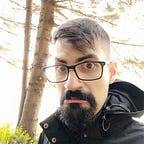Everything is about Trust
In the current days with economic, government and business crises, it is necessary to remember that the world works by trust. For example, nowadays money is not real (or physical), its value is given by the trust that people have in it.
…Distrust leads to fear…fear leads to anger…anger leads to hate…hate leads to suffering.
Towards a more reliable world
Edelman does this survey every year around trust and what the people are thinking. So people trust more in people like themselves than they trust governments or corporations. I guess this is understandable because reasons like: big corporate scandals, Panama Papers, impunity of those who incited the great financial crisis, etc.
But in my opinion, there is good news: the future belongs to the people and the trust in everyone.
Money is not real
Since the Gold Standard ended, all money in the world can not be supported by something physical and its value is established by the trust that people have in it and belonging to one person or another is handled by ledgers controlled by corporations and governments.
A collective fiction, as Neha Narula said in a TED talk: “Money is about the exchanges and the transactions that we have with each other. Money isn’t anything objective. It’s about a collective story that we tell each other about value”.
The bitcoin’s value is fixed by the trust of people, through supply and demand.
Distributed trust
The 20th century was defined by institutional trust. It was the government or corporations that said why we should trust them. But the 21st century is being governed by a distributed trust: it’s the people who establish why we should trust each other according to common interests.
Many people don’t trust the political parties that control their country, but would trust a stranger to rent their houses in holidays. This is why services (like Airbnb) have a distributed trust, where it’s the people who value other people to increase the trust.
The way trust flows through society is changing.
The Yapese people
There is an island called the Yap and it is located in the Caroline islands that had Spanish, German and Japanese influence and it was a battleground in World War II.
The special thing was its economy system during the 20th century, in fact the Yap is known for its stone money, known as Rai: large disks carved up to 12 ft in diameter.
The Rai’s were built with stones from others islands, through mining or trade with strange peoples.
The effort and the peril required to get these disks, made them valuable to the Yapese people.
Currently their value is given by its size and its history.
The Yapese know who owns which stone but not necessarily move them when the ownership changes. So they just keep track of who owns what stone.
This simple mechanism is how our money works, the ownership is handled by ledgers and everyone (or the majority) agree with that.
Blockchain
The blockchain is one of the most commons words actually, but what actually is it?.
The Harvard Business Review described Blockchain like this: “blockchain is an open, distributed ledger that can record transactions between two parties efficiently and in a verifiable and permanent way”.
Computationally, it is a linked list (of blocks), immutable and secured by cryptography. Every block keeps a hash generated by its data and timestamp, and one reference to the previous block’s hash. This mechanism makes a “chain”.
Satoshi Nakamoto
The first blockchain was conceptually in 2008 by an anonymous person or group known as Satoshi Nakamoto. In 2009 was implemented as a core component of Bitcoin where it serves as public ledger for all transactions.
You can access the Satoshi’s paper here.
It is not just about money
Money is one of use cases, but it’s not the only one. Every block in this chain is like an electronic document where we’ll fill it up with assets.
One asset can be anything you can imagine, I’m going to list some:
- Property title.
- Stock trade.
- Intellectual property (music, art, etc).
- Contracts.
- Votes.
- Money (Bitcoin, Ethereum, etc).
How the trust is established by cryptography and by collaboration in this decentralized chain, people can trust in each other and transact peer to peer without big corporations control that. This is brilliant.
The blocks are secure
A block is a bunch of transactions (Bitcoin save 10 transactions per block). This block must be mined and transfer to every participant in blockchain before it appends to the chain. Once a block is mined, this is inmutable and any hacking attempt force all chain’s members to mine all blocks again.
The concept “mine a block” means that an encrypted hash is generated with the block data, the timestamp, the previous hash in the chain and a “nonce” unknown. This hash must meet some requirements.
Finding that nonce and meeting those requirements has a large computational cost. But it also has a reward (mining bitcoin blocks will give you 10 or 12 bitcoins). You cannot mining alone, if you are interested in, you’ll need to join farms, which are groups of people who mine together and share the reward. But you’ll also need to have a powerful hardware.
A democratized chain
The blockchain works as long as most people want it to work. This is the fascinating thing: everything is about trust and the people like you and me. The end of the corporations is near, it’s time for us.
Conclusion
That is my vision of our great world. We can create a better world together. Obviously not everything is good, this new world brings us risks and dangers but it will undoubtedly be a much more collective world.
I hope you enjoyed reading, if you have any questions, suggestions or whatever, let me know!. You can find me on Twitter.
In the next post, I going to implement my own blockchain.
